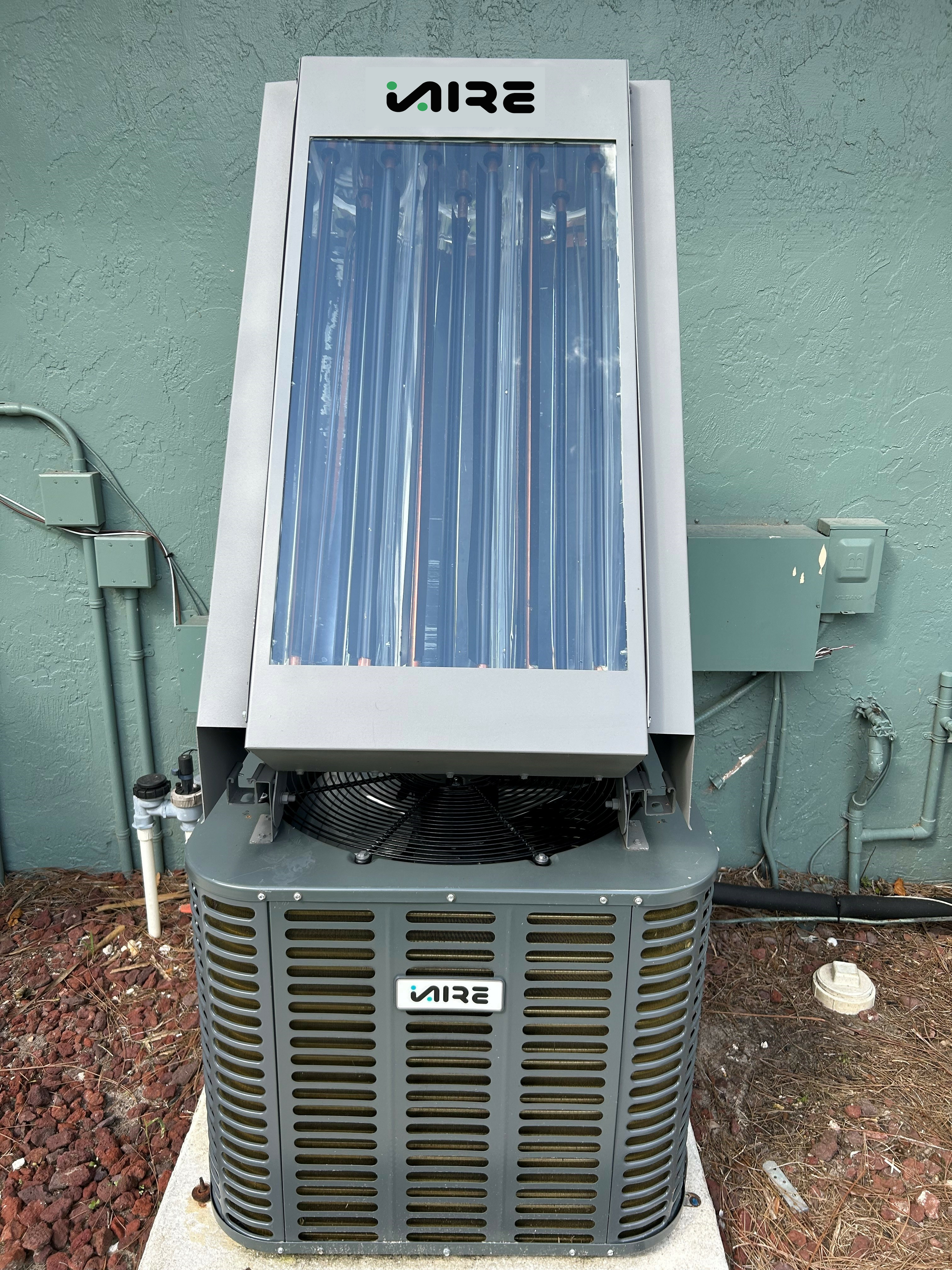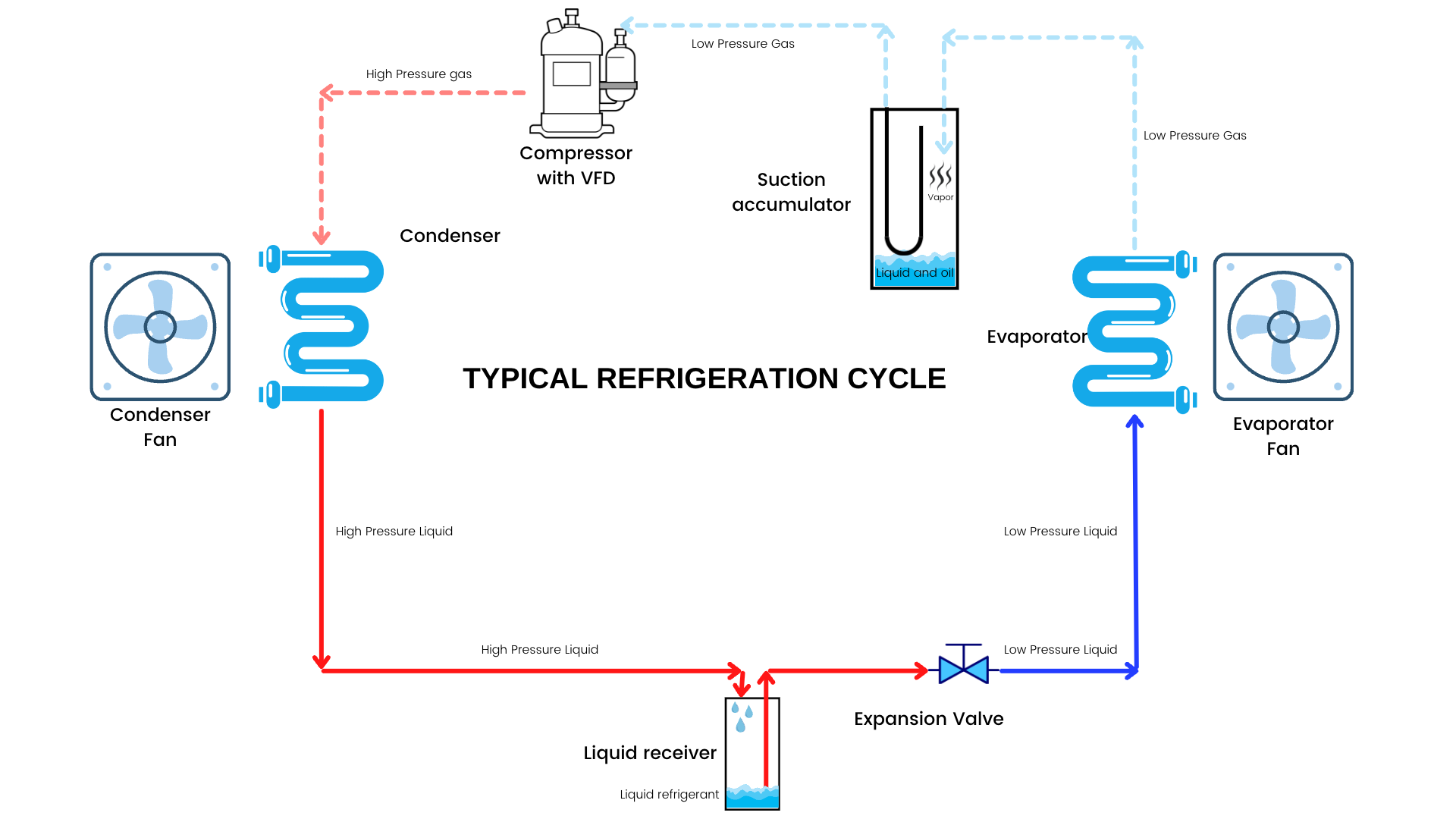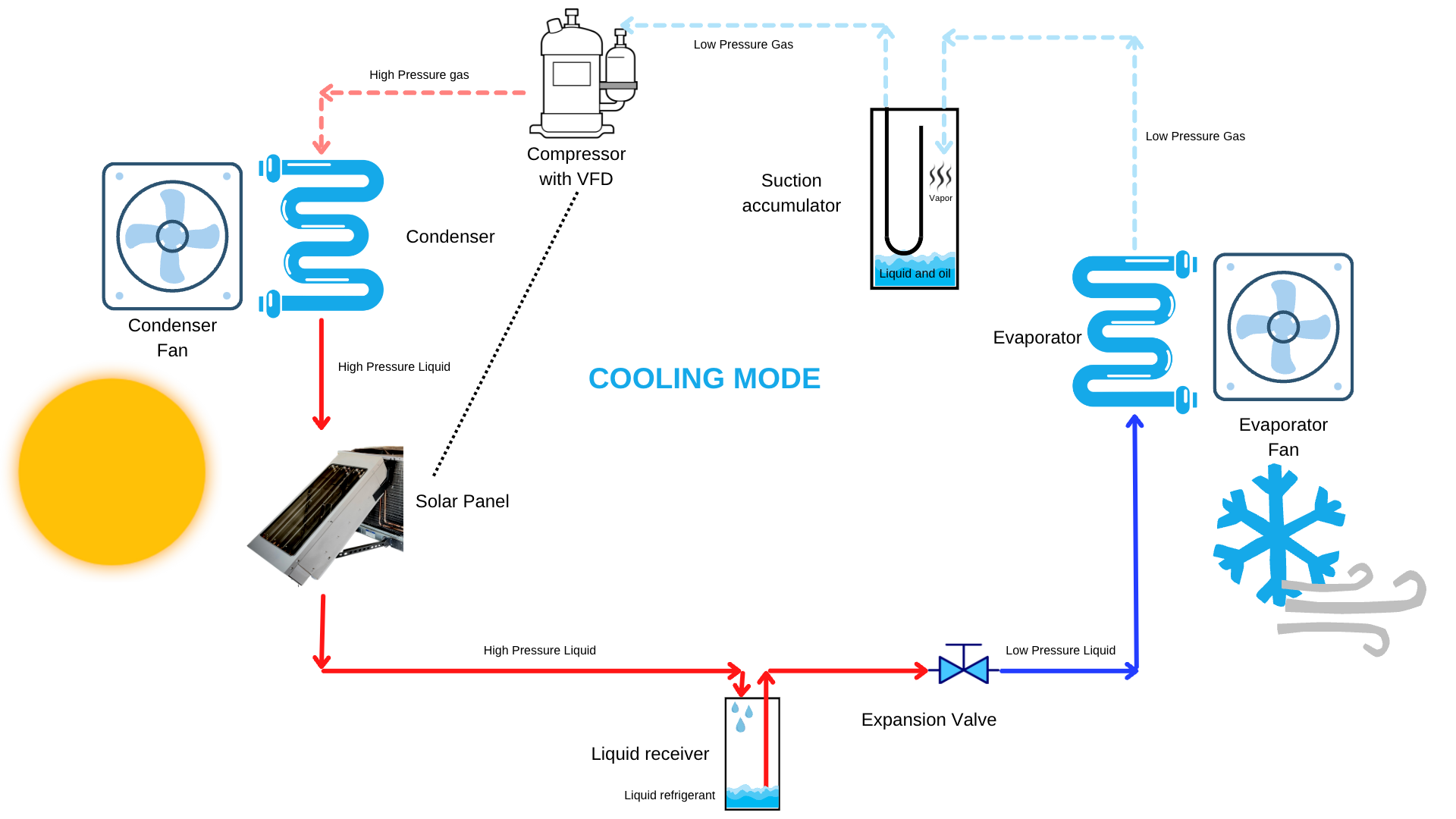Solar HVAC
Energy-Efficient Solar HVAC Units
iAIRE’s patented Solar HVAC units harness the sun’s energy to create an HVAC system that can be 50% more efficient than any other units currently on the market. This technology is available for both residential and commercial HVAC equipment.
We have set up a 2 ton residential unit, located in South Florida, to view energy savings on a live unit.

How Solar HVAC Works
To help describe how the iAIRE patented system works, iAIRE will give a brief explanation of how a standard HVAC system works and then discuss how the iAIRE Solar HVAC system works.
In an HVAC system temperature and pressure are directly correlated. Whenever there is an increase in pressure in the HVAC system, there is a corresponding increase in temperature. If there is a decrease in pressure, there is a decrease in temperature.

Refrigerant Diagram with iSolarHVAC

There is a compressor in the system that pressurizes the refrigerant to move it through the system and heat the refrigerant. This refrigerant then travels through the condenser (the unit that is normally sitting outside your house) where the hot temperature is emitted to the atmosphere to help cool the refrigerant down. The refrigerant is then piped over to the evaporator coil. This coil is located in the Air Handling Unit (AHU) that is normally inside your house. Warm air from the house is passed across the cool coil. This cools down the air and in many cases also removes moisture. The warmer refrigerant is then returned back to the compressor and the cycle is repeated over and over again.
How iAIRE Solar HVAC Systems Are Different
In lieu of generating electricity, the solar panel on the iAIRE Solar HVAC generates heat. The panel is installed on the condensing unit. There is a VFD installed on the compressor. The Solar HVAC unit utilizes the sun’s energy to put heat into the refrigerant. This process replaces a portion of the energy the compressor would normally put into the system from the electrical network in the building.
There are sensors in the condensing unit that sense pressure or temperature and provide feedback to the HVAC controls indicating how the system is operating. As the solar panel adds more heat to the system, the VFD slows down the speed of the compressor to keep the system running at its normal operating pressure. As the compressor runs slower, it utilizes less electricity to operate. The compressor is normally the item in the HVAC system that uses the most energy. many times utilizing up to one-half the energy normally required to operate an HVAC system.
iAIRE Solar HVAC Results
iAIRE is the first manufacturer to add a solar panel, a VFD to the compressor, and control logic as a complete package to an HVAC unit. iAIRE’s Solar HVAC uses a unique solar film developed by the NREL, which is more efficient than the film used in standard solar panels. This film does not need direct sunlight to produce heat. It utilizes all spectrums of light produced by the sun to generate heat. The panel produces the most energy in direct sunlight, but even on cloudy days, the solar panel will provide heat to the system since this film operates even with ambient light. This is different than most standard solar panels that need direct sunlight to operate. The solar panels are all unit-mounted to new equipment or retrofitted in the field as a modification, saving on real estate. They are installed as one single package, not requiring a remote-mounted solar panel.
iAIRE’s 5-ton solar panel is about the same physical size as a single solar panel that is normally installed on a house roof. A solar panel on a house provides approximately 1.34 amps when it is sunny outside. iAIRE’s solar panel does not provide electricity. It reduces the amount of electricity consumed by the compressor. On the same sunny day that a standard solar panel produces 1.34 amps, the iAIRE solar panel reduces almost 10 amps of draw on the compressor. To get the same result, a homeowner would have to install 7+ solar panels on their rooftop. This is an amazing amount of additional energy provided by the same size solar panel.
Click here to view (right click to download) iAire’s FAQ’s for more information.
IS SOLAR HVAC COST EFFECTIVE?
Solar HVAC has a substantial on-going utility savings over conventional HVAC equipment. These savings usually amounts to 40 – 50% of the energy that is used by the HVAC equipment, along with the fact that since the Solar HVAC has an inverter on the compressor, the in-rush current is low and if the utility in the area has peak demand electrical charges, these are eliminated or minimized by Solar HVAC.
In addition to the Solar HVAC utility savings, there are many incentives that federal, state, and local governments are providing for solar projects. There are also many utility incentives for these projects. For a complete list of these programs, go to https://www.dsireusa.org/. This website was created by NC State University and has Federal, State, local and power companies providing incentives for every state around the country.
In August 2022, Congress passed a revision to the Investment Tax Credit (“ITC”), which provides a 30% tax credit for systems installed between 2022 – 2031. The credit will be increased another 10% for solar equipment built in America and would increase the tax credit another 20% for solar equipment installed in certain low-income housing applications.
There is no maximum amount that can be claimed, and the credit can be transferred from one party to another. Since iAIRE makes our solar panels in the US, iAIRE would be eligible for a 40% Federal tax credit on normal jobs and 60% on low-income housing. iAIRE has written a document to show both businesses and homeowners how to obtain this tax credit.
The tax code also allows for an accelerated depreciation schedule on solar projects. At the current rebate rate of 40%, a business could depreciate 80% of the cost of the equipment and installation the first year. Also, most states are not charging sales tax on solar projects.
The up-front cost for Solar HVAC is more than conventional equipment. Because of this, most people believe there is still a long payback period to pay for the additional cost of utilizing Solar HVAC over conventional equipment. Below iAIRE will show a couple of examples of the use of Solar HVAC compared to conventional equipment to show that the payback on projects can be seen as rapidly as the first year.
This chart is an example of a 5-ton packaged roof top unit replacement on a store in Orlando Fl.
(click image to enlarge)
This analysis assumes a 40% Federal Tax credit, no sales tax, and a $0.13/kwh cost for power. The numbers show that this customer would experience a first-year savings of $2586.03 and then the ongoing savings from installing Solar HVAC will save this customer $14,209.76 over the first 7 years of the HVAC equipment’s life.
This chart is an example of a large commercial new construction job where the customer chose Solar HVAC over conventional equipment in Columbus, IN.
(click image to enlarge)
This analysis assumes a 40% Federal Tax credit, no sales tax, and a $0.12/kwh cost for power. The numbers show that this customer would experience a first-year savings of $596,971.24 and then the ongoing savings from installing Solar HVAC would save this customer $684,610.06 over the first 7 years of the HVAC equipment’s life.
As shown above, Solar HVAC can have a payback as quickly as the first year. In almost all cases, the payback on Solar HVAC is 3 years or less when installed on new equipment. Please contact iAIRE for more information or to discuss your specific project or questions.
Patented Technology
Our state-of-the-art solar HVAC equipment incorporates innovative technologies protected under a collection of patents. These patents have been licensed from Climate Saver, ensuring that we utilize cutting-edge, legally safeguarded methods and designs. Our equipment is built on the foundation of the following United States Patents:
– US Patent #9,810,455
– US Patent #10,982,862
– US Patent #10,900,694
– US Patent #11,143,437
These patents underline our commitment to delivering advanced and efficient solutions in the field of solar energy and HVAC systems. We are proud to bring our customers products developed at the forefront of technology and environmental sustainability.
Solar HVAC Documents
Model “Z” Condenser Only Units:
2 Ton Cooling Only | 2 Ton Heat Pump
3 Ton Cooling Only | 3 Ton Heat Pump
4 Ton Cooling Only | 4 Ton Heat Pump
5 Ton Cooling Only | 5 Ton Heat Pump
Multi-Split Units:
1.5 Ton Heat Pump
2 Ton Heat Pump
3 Ton Heat Pump
4 Ton Heat Pump
5 Ton Heat Pump
Multi-Split AHU Units:
Model “Z” Condenser with Model “A” A-Coil Units:
2 Ton A-Coil
3 Ton A-Coil
4 Ton A-Coil
5 Ton A-Coil
Model “Z” Condenser UltraRes Units:
2 Ton Cooling Only | 2 Ton Heat Pump
3 Ton Cooling Only | 3 Ton Heat Pump
4 Ton Cooling Only | 4 Ton Heat Pump
5 Ton Cooling Only | 5 Ton Heat Pump
Model “Z” Condenser with Model “Z” AHU Units:
2 Ton Cooling Only | 2 Ton Heat Pump
3 Ton Cooling Only | 3 Ton Heat Pump
4 Ton Cooling Only | 4 Ton Heat Pump
5 Ton Cooling Only | 5 Ton Heat Pump


